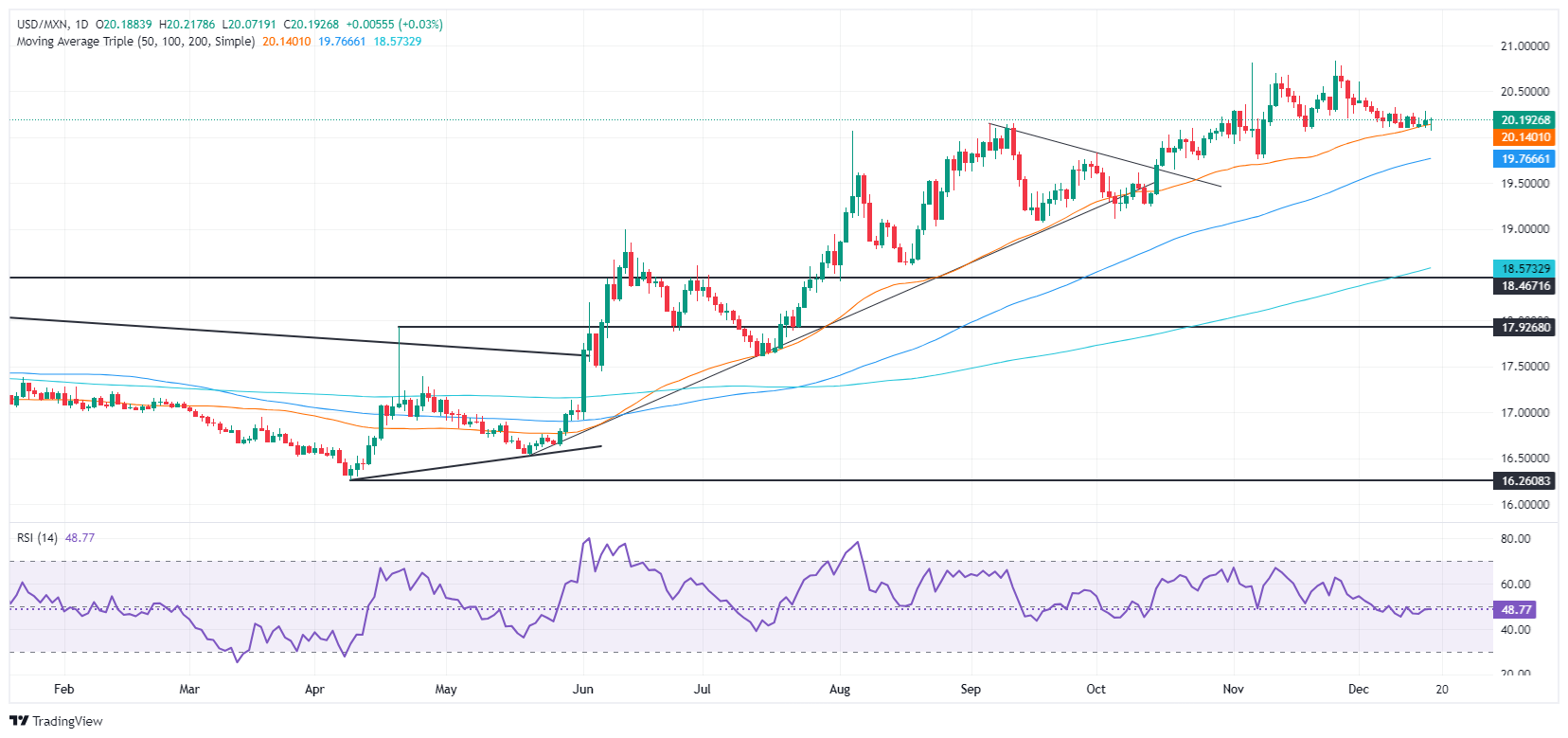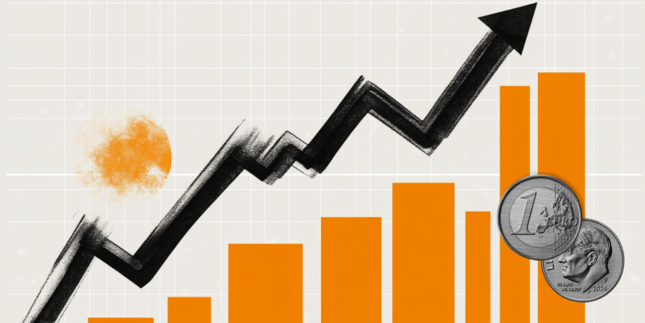Mexican Peso depreciates as Fed signal two rate cuts in 2025, eyes on Banxico
- Mexican Peso dips after Fed cuts rates by 25bps; gradual future easing signaled.
- Fed Chair Powell highlights persistent inflation risks, impacts on emerging currencies like Peso.
- Fed's SEP shows rate to drop to 3.9% by 2025, 3.4% by 2026 amid modest cut expectations.
The Mexican Peso dives against the US Dollar after the Federal Reserve (Fed) lowered interest rates but adopted a less dovish stance, eyeing just 50 basis points of easing for 2025. At the time of writing, the USD/MXN trades at 20.40, up by over 1%.
Recently, Federal Reserve Chair Jerome Powell crossed the wires and indicated that the central bank may adopt a more cautious approach to future policy adjustments, noting that current measures are less restrictive. He emphasized that inflation risks and uncertainties remain tilted to the upside, partly explaining the dot plot changes.
Powell also projected that it could take one to two years for inflation to return to the 2% target while assuring that the labor market's current state does not raise significant concerns about overheating.
Earlier, the Federal Reserve lowered interest rates by 25 basis points (bps) to the 4.25%-4.50% range. Yet, the decision was not unanimous, as Cleveland Fed President Beth Hammack opted to keep rates unchanged.
Market participants, however, paid less attention to the statement and instead focused on the Summary of Economic Projections (SEP). The SEP includes the dot plot, which reflects Fed officials' perspectives on the projected path of interest rates. Policymakers project just two cuts for 2025 and two more for 2026. Officials estimate the Fed funds rate to end at 3.9% in 2025 and 3.4% in 2026.
Other projections suggest that the Fed’s favorite inflation gauge, the Core PCE, is expected to end at 2.8% in 2024, 2.5 % in 2025, and 2.2% in 2026. Regarding growth, the economy is foreseen to end at 2.5% in 2024, 2.1% in 2025, and 2% in 2026.
The Unemployment Rate is expected to end the current year at 4.4% and remain unchanged at 4.3% in 2025 and 2026.
In addition, Mexico’s economic docket revealed that private spending increased in the third quarter, as revealed by the Instituto Nacional de Estadistica Geografia e Informatica (INEGI).
On December 19, the Banco de Mexico (Banxico) is expected to cut interest rates by a quarter of a percentage point to 10.00%
Ahead this week, Mexico’s docket will feature Banxico's monetary policy. in the US, investors will also focus on Thursday's US GDP data and the Fed’s favorite inflation gauge, the core Personal Consumption Expenditures (PCE) Price Index, which could impact Bullion demand.
Daily digest market movers: Mexican Peso weakens as USD/MXN rises above 20.35
- Mexico Private Spending in Q3 rose by 1.1% QoQ, above Q2 0.6% expansion. Yearly, dipped from 3.3% to 2.9% for the same period.
- Mexican Retail Sales for October disappointed investors, missing estimates on monthly and annual figures, which indicates that the economy continues to slow down.
- Banxico's December private sector survey forecasts Mexico's inflation to close 2024 at 4.37%, with core inflation easing to 3.60%, down from November’s 3.69%. Economic growth is expected at 1.60%, up from the previous 1.53%, while the USD/MXN exchange rate is projected at 20.25.
- For 2025, inflation is expected to decline to 3.80%, while core inflation is projected to rise slightly to 3.72%. GDP growth is forecast at 1.12%, lower than November’s 1.20% estimate, and the USD/MXN exchange rate is anticipated to reach 20.53.T
- Analysts at JPMorgan hinted that Banxico could lower rates by 50 basis points as inflation data shows that prices are edging lower faster than expected.
USD/MXN technical outlook: Mexican Peso remains steady at round 50-day SMA
The USD/MXN remains upward biased, with the pair bottoming near the 50-day Simple Moving Average (SMA) at 20.11. Momentum is sideways, as depicted by the Relative Strength Index (RSI) almost flat at its neutral line. Hence, the exotic pair has found acceptance at around the 20.00-20.20 range, ahead of the end of 2025.
For a bullish continuation, buyers must clear 20.20 before challenging the psychological 20.50. On further strength, the next resistance would be the December 2 daily high of 20.59, followed by the year-to-date peak of 20.82 and the 21.00 mark.
Conversely, if USD/MXN falls beneath the 50-day Simple Moving Average (SMA) at 20.11, the next support would be 20.00. Further downside is seen at the 100-day SMA at 19.74, ahead of exposing 19.50.

Mexican Peso FAQs
The Mexican Peso (MXN) is the most traded currency among its Latin American peers. Its value is broadly determined by the performance of the Mexican economy, the country’s central bank’s policy, the amount of foreign investment in the country and even the levels of remittances sent by Mexicans who live abroad, particularly in the United States. Geopolitical trends can also move MXN: for example, the process of nearshoring – or the decision by some firms to relocate manufacturing capacity and supply chains closer to their home countries – is also seen as a catalyst for the Mexican currency as the country is considered a key manufacturing hub in the American continent. Another catalyst for MXN is Oil prices as Mexico is a key exporter of the commodity.
The main objective of Mexico’s central bank, also known as Banxico, is to maintain inflation at low and stable levels (at or close to its target of 3%, the midpoint in a tolerance band of between 2% and 4%). To this end, the bank sets an appropriate level of interest rates. When inflation is too high, Banxico will attempt to tame it by raising interest rates, making it more expensive for households and businesses to borrow money, thus cooling demand and the overall economy. Higher interest rates are generally positive for the Mexican Peso (MXN) as they lead to higher yields, making the country a more attractive place for investors. On the contrary, lower interest rates tend to weaken MXN.
Macroeconomic data releases are key to assess the state of the economy and can have an impact on the Mexican Peso (MXN) valuation. A strong Mexican economy, based on high economic growth, low unemployment and high confidence is good for MXN. Not only does it attract more foreign investment but it may encourage the Bank of Mexico (Banxico) to increase interest rates, particularly if this strength comes together with elevated inflation. However, if economic data is weak, MXN is likely to depreciate.
As an emerging-market currency, the Mexican Peso (MXN) tends to strive during risk-on periods, or when investors perceive that broader market risks are low and thus are eager to engage with investments that carry a higher risk. Conversely, MXN tends to weaken at times of market turbulence or economic uncertainty as investors tend to sell higher-risk assets and flee to the more-stable safe havens.
Forex News
Keep up with the financial markets, know what's happening and what is affecting the markets with our latest market updates. Analyze market movers, trends and build your trading strategies accordingly.























